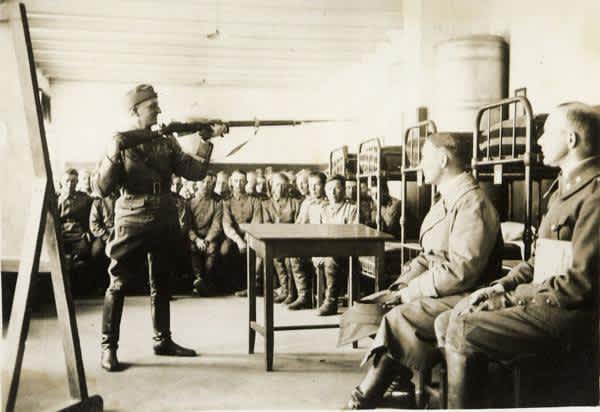The Finnish m/39: History
Matt Korovesis 06.15.11

This article is part of a series on the Finnish m/39 rifle. To read about the specs of the rifle, click here. To read about taking the rifle to the range, click here.
When it comes to military surplus rifles that combine history, utility and a high degree of collectible attributes, few compare to the Finnish m/39 infantry rifle. One of the final “new” bolt action designs to be accepted into use as a standard issue rifle for a nation’s armed forces, the m/39 represents the culmination of decades of practical experience in firearms usage. Its ergonomics, simplicity and reliability made it the perfect choice for a country constantly in conflict with its neighbor, and these features are part of what makes them even more attractive for today’s surplus rifle collector and shooter. These articles will cover the basic history, specifications and use of the m/39 rifle.
As the rifle’s name implies, the m/39 was designed in 1939 and accepted for standard issue for the Finnish Army in 1940. The Finnish government, realizing that their imperialist neighbor (the Soviet Union) would be their most likely opponent in any conflict, wisely chose to equip their armed forces with small arms of the same caliber and type as the Soviet Red Army. The m/39 is the final evolution of the Mosin-Nagant (hereafter referred to as simply the Mosin) rifle that had been in use by the Russian Army in its Imperial and Soviet guises since 1891. In addition to using purchased and captured Russian versions of the Mosin, the Finns designed their own variations.
Mosin rifles first saw action in Finland during the Russian and Finnish Civil Wars. At the time, the Grand Duchy of Finland was a territory of the Russian Empire. When the Bolsheviks seized power in 1917, the Finnish people saw their opportunity to attain their independence from Russia. What followed the separation was a bloody civil war (January 1918-May 1918) between Whites (usually farmers, members of the middle class and liberals) and Reds (leftists, communists, socialists and so on) of their own, which saw the defeat of the Finnish Reds. Following a brief period under the aegis of the German Empire, an independent Finnish republic emerged, always wary of its big Soviet neighbor and its imperial ambitions.
Following the tumultuous civil war, years of peace saw the introduction of many new Finnish versions of the rifle; these include the m/27, m/28 and m/28-30. All were shortened versions of the lance-like length of the original Imperial Russian Model 1891. However, many Russian rifles simply done over with Finnish markings were also present in the nation’s arsenals—before the m/39, the m/27 was the only model approved for standard issue by the Finnish Army, the m/28 and m/28-30 were specifically made for the Civil Guard, a paramilitary anti-leftist holdover from the Civil War.
The m/39 rifle first began production in 1940 and was made until 1945. A number of m/39s were also built in the late 60s and early 70s for training and sporting use—these will often be in the best condition, though some may consider them to have less “history” in them, though the receivers used are often just as old and storied as the war era examples. The m/39 was built by SAKO (the SAKO that continues to make amazing firearms to this day) and VKT (a state rifle factory, later Valmet and now defunct).
SAKO manufacture is indicated on the top of the receiver by a S-in-gear logo, VKT by the letters VKT in a polygon. Some receivers have a T in a triangle or T in a triangle circumscribed by a circle; this indicates the barrel was made by the Tikkakoski group. Furthermore, some receivers have a capital B on them, research indicates that barrels marked as such were made in Belgium. Rifles with a “Sk.Y” on the receiver were made by SAKO for the Civil Guard, they are not a unique manufacturer. Many rifles made in the 60s and 70s have no markings on the receiver other than serial numbers and their precise manufacturer is uncertain. Though reliable numbers are hard to come by, compiled statistics from SAKO, VKT and Tikkakoski imply that a little more than 120,000 m/39s were built by 1945.
It is important to note that all Finnish Mosins are essentially “parts guns” – though they made their own barrels, stocks and various other parts of the gun, the Finns never manufactured their own receivers, only using Russian-made ones with new markings. I’ve personally handled Finn Mosins with combinations of parts made in the United States (Imperial Russia had a brief and ultimately incomplete contract with Remington and New England Westinghouse for the original m/91 rifle during World War I), Russia and Finland itself. However, attributing the same derision that most collectors place on a rifle when they hear “parts gun” would be incorrect. All of the various parts put together in a rifle were held to a high standard to ensure flawless functionality.
The m/39 would not see service in the Winter War, the first large scale confrontation between the USSR and Finland which lasted from November 1939 to March 1940. The earlier Finnish variants of the rifle certainly did, however. The story of the Winter War itself is an inspiring one of a tiny nation standing against an aggressive neighbor and surviving, albeit with little less territory than before. The m/39 would earn its reputation as an exceptional small arm in the Continuation War (1941-1944), what the Finns call their part of World War II, in which Finland fought as a co-belligerent of Nazi Germany against the Soviet Union. Its well-earned reputation and unique history have led the Finnish m/39 to its prominent place in many collections.

